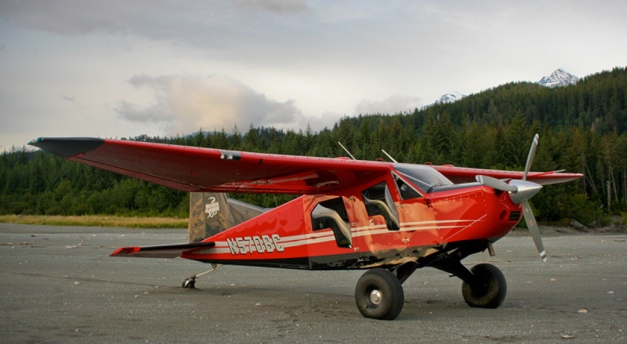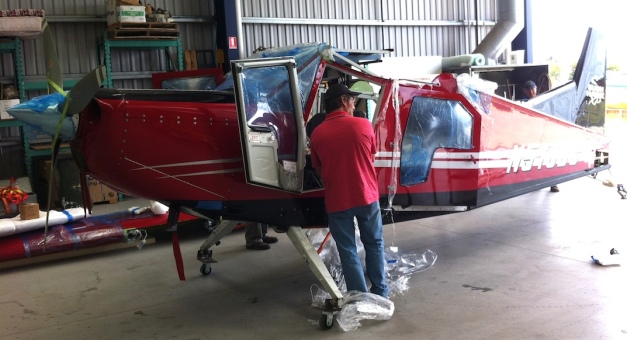
Lainey’s first flight
I’m aiming for this to be the first in a series about simple aircraft. The series will be about easy flying in light aircraft, sometimes with nothing but an airspeed indicator, a slip ball, a tachometer, and an oil pressure gauge. These aircraft are all about a love of flying, pure and simple, without the need to get somewhere by a certain time and without the need for all the latest digital gadgets beloved by so many of us pilots.
I’m hoping it will re-kindle that wonder of getting off the ground, maybe just after dawn on a clear winter morning, or taking off into one of those warm, still summer evenings, when the long shadows give such an amazing sense of depth and contrast.
And where else to start but with the Piper J-3 Cub…
The J-3 Cub is thought by many to be the aircraft which personifies the essence of flying: near perfect control harmonisation, the third wheel at the back (where many old-timers say is the only place it should be) and complete simplicity of operation – no flaps and an ‘armstrong’ engine starter (there’s no electrical system). Although flown solo from the rear seat due to centre of gravity requirements, nevertheless, the J-3 Cub is an easy plane to fly…everything happens very slowly. If there is such a thing, the ‘typical’ J-3 is powered by an engine of only 65hp – but remember, this is a very light aircraft, even by today’s standards, and 65hp is plenty enough for all but the heaviest of crew on the hottest of days.
The very first Piper Cub, the J-2, had its origins in 1930 in the Taylor E-2 Cub, manufactured by Taylor Aircraft in Bradford, Pennsylvania. This aircraft, sponsored by William T. Piper, a local industrialist, was intended to be an inexpensive introduction to aviation but the Taylor company went bankrupt within a year and Piper bought the assets, although retaining C. Gilbert Taylor as president and also the company name. From a slow start, Taylor/Piper eventually built about 1,200 J-2 aircraft in the 1930s before a fire at the Bradford factory halted production.

J-3 instrument panel simplicity
In 1938, the company was re-established as Piper Aircraft, the factory was relocated to Lock Haven, Pennsylvania and the J-3 was born. The J-3 featured, among other changes, a more integrated design of tail fin and a steerable tailwheel. It was originally powered by a 40hp engine and cost about $1,000 – for relevance, the average cost of a new car in USA was around $675 at that time. When the second world war broke out, the J-3 became the military trainer of choice and by the end of 1940, when the USA joined the war, over 3,000 J-3s had been built, powered by a number of different engines, designated by a suffix letter: J-3C (Continental), J-3L (Lycoming), J-3F (Franklin) and so on. At one point during the war, it is estimated that a J-3 was coming off the production line every 20 minutes!
During the late 1930s and 1940s around 20,000 J-3 Cubs were built, many designated as the military ‘L-4’ version. Since then, tens of thousands of Cub variants have been designed and built by Piper, most famously the Super Cub, with powerful 150+hp engines, which give exhilarating performance, albeit at the expense of some of the endearing flight characteristics of the original J-3.
Sadly, in 1994, Piper went into liquidation and they stopped building the Cub. However, the aircraft lives on and various versions of it are now built in the USA both as certified GA aircraft and as Light Sport Aircraft (LSA) by Cubcrafters (in Yakima, Washington state), and American Legend Aircraft (in Sulphur Springs, Texas).
Here are some links to a few of my very favourite Cub videos (click on the names to connect):
The Classic Piper Cub – a short introduction to, and history of, the Piper Cub
Lainey’s first plane ride – a magical short video about a little girl’s first flight – in a J-3 Cub, of course. Reminds me of taking my own grandson, Ollie, for his first flight in my Foxbat about a year ago
The Yellow Piper – by Kristina Olsen, about learning to fly in a boyfriend’s Cub
Golden Wings – just the J-3 taking off, flying and landing
Dreams of Flying – an excerpt from the well-known video ‘One-Six Right’ featuring a J-3 Cub
And finally, if you are thinking of acquiring a J-3 Cub, there are hundreds in the USA. Have a look at Barnstormers.com aircraft for sale – hit the search button near the top of the home page, scroll down the menu on the left and click ‘Piper’ then scroll down and hit ‘J-3 Cub’. There’s usually a reasonable range, from basket cases to newly restored.
 Just Aircraft has recently installed a Titan XO-340 180-hp engine in their Super STOL (Short Take-Off & Landing) aircraft. The take-off results are spectacular – watch the on-board video clip and you’ll se what I mean! Remember – this is not a view from a helicopter, although it might ‘just’ as well be! Not only is the take-off distance short but the aircraft keeps on climbing.
Just Aircraft has recently installed a Titan XO-340 180-hp engine in their Super STOL (Short Take-Off & Landing) aircraft. The take-off results are spectacular – watch the on-board video clip and you’ll se what I mean! Remember – this is not a view from a helicopter, although it might ‘just’ as well be! Not only is the take-off distance short but the aircraft keeps on climbing.




